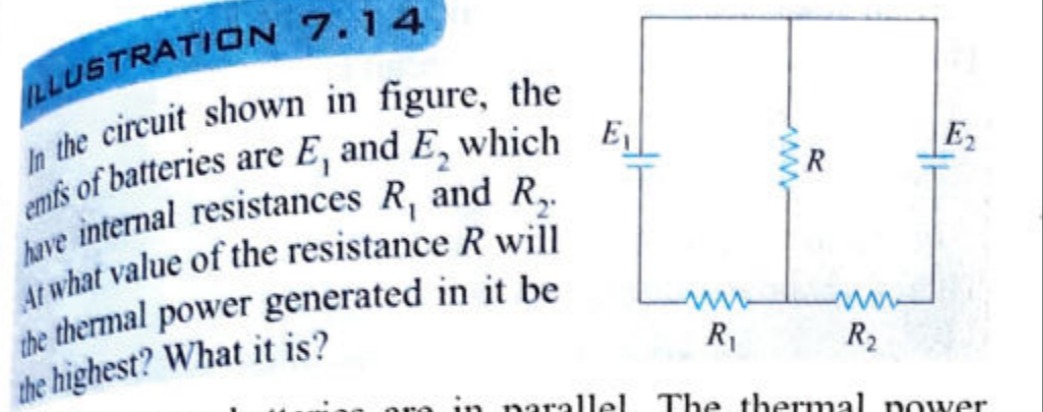Question
Question: In the circuit shown in figure, the emfs of batteries are $E_1$ and $E_2$ which have internal resist...
In the circuit shown in figure, the emfs of batteries are E1 and E2 which have internal resistances R1 and R2. At what value of the resistance R will the thermal power generated in it be the highest? What it is?

The thermal power generated in resistance R is highest when R=R1+R2R1R2.
The thermal power generated in resistance R is highest when R=R1+R2.
The thermal power generated in resistance R is highest when R=R1+R2E1R2+E2R1.
The thermal power generated in resistance R is highest when R=R1E1+R2E2.
The thermal power generated in resistance R is highest when R=R1+R2R1R2. The highest thermal power generated is Pmax=4R1R2(R1+R2)(E1R2+E2R1)2.
Solution
The thermal power generated in resistor R is given by P=RV2, where V is the voltage across R. By applying Kirchhoff's laws, we can express V in terms of the circuit parameters. The currents through the branches with batteries are I1=R1E1−V and I2=R2E2−V. By Kirchhoff's current law at the junction, I1+I2=RV. Substituting the expressions for I1 and I2: R1E1−V+R2E2−V=RV R1E1+R2E2=V(R1+R11+R21) Let S=R1E1+R2E2 and G=R11+R21. Then, S=V(R1+G), which gives V=R1+GS=1+GRSR. The power is P(R)=RV2=R1(1+GRSR)2=(1+GR)2S2R. To maximize P(R), we find dRdP and set it to zero: dRdP=S2(1+GR)4(1+GR)2−R⋅2(1+GR)G=S2(1+GR)31−GR Setting dRdP=0 gives 1−GR=0, so R=G1. Substituting G=R11+R21=R1R2R1+R2, we get: R=R1R2R1+R21=R1+R2R1R2 The maximum power is obtained by substituting R=G1 into the power equation: Pmax=(1+G(1/G))2S2(1/G)=22S2/G=4GS2 Substituting S=R1E1+R2E2=R1R2E1R2+E2R1 and G=R1R2R1+R2: Pmax=4(R1R2R1+R2)1(R1R2E1R2+E2R1)2=4(R1+R2)R1R2(R1R2)2(E1R2+E2R1)2=4R1R2(R1+R2)(E1R2+E2R1)2
